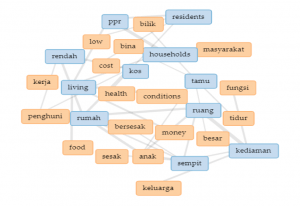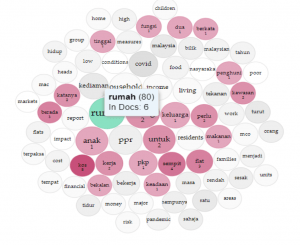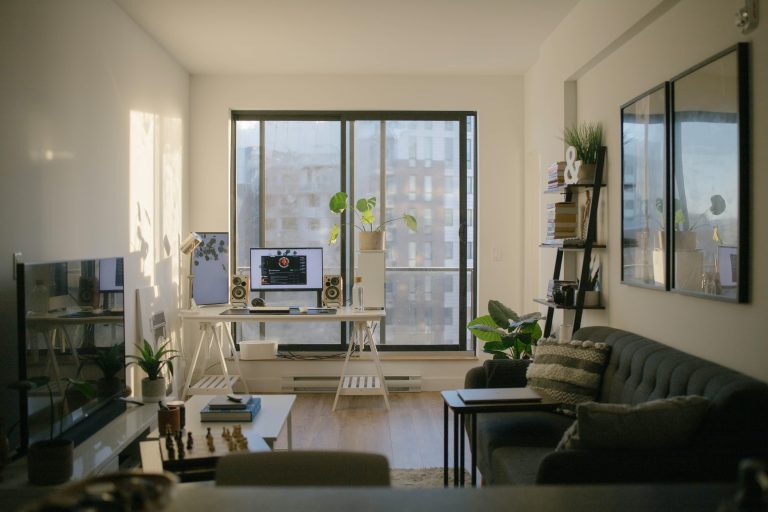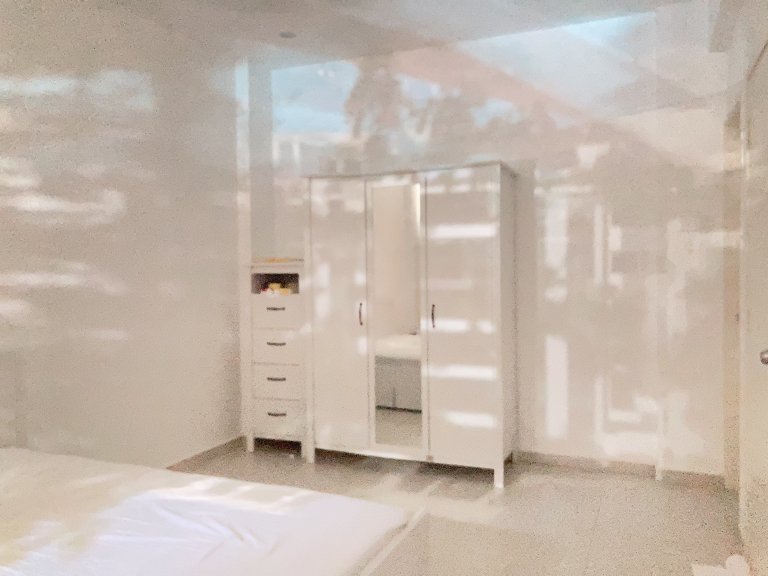Article
Behavior Analytics on Energy Consumptions
Space and behaviour are deemed to have a significant impact on how humans interact with their surroundings. Due to this, the Movement of Restriction Order (MCO) during the COVID-19 pandemic has ignite a great deal of public outrage and grievances. As a consequence, it has affected the general public’s home comfort and mental health, causing feelings of depression, anxiety, and fear. Sensibly, the level of comfort in the home is determined by financial resources. Some people can afford a large house with plenty of rooms, while others can only afford a small flat despite having large families. Household comfort is inextricably linked to the amount of living space available. In Malaysia, government-built homes for lower-income families are very typical, and are commonly found to be a basic unit plan of two bedrooms and one bathroom. According to a study published in April 2020 on the effects of (M)movement (C)control (O)orders (MCO) in Malaysia, 25 to 32 percent of people who experiences mental stress lives in low-cost housing areas such as Projek Perumahan Rakyat (PPR), and are more likely to suffer from depression, anxiety, and extreme anxiety [1]Sureen Faris Abdul Shukor. Reka bentuk PPR pengaruhi tekanan mental penghuni semasa PKP. https://frsb.upm.edu.my/article/the_ppr_design_affects_the_mental_health_of_the_population_during_the_cpp-56832 . The lack of space in a house shared by several generations of family member is one of the elements that contributes to mental stress. Ever since moving to PPR, a household consisting three generations of family members are found to have been unable to fit inside the 650-700 square foot space available (comfortably) [2]Sureen Faris Abdul Shukor. Reka bentuk PPR pengaruhi tekanan mental penghuni semasa … Continue reading
.
The tenants of PPR flats have expressed their dissatisfaction, unfitness, and tension as a result of the government’s long-term lockdown order. These situations has been reported in many online news/newspaper
Content analysis was performed on a collection of online news [3]Raziatul Hanum. Penghuni rumah pangsa tanpa balkoni lebih tertekan, kata pakar. Free Malaysia Today. … Continue reading [4]Nur Hasliza Mohd Salleh. Sukarnya hidup di flat PPR dalam tempoh perintah kawalan. Free Malaysia Today. … Continue reading [5]Warga emas tinggal berhimpit bersama 15 ahli keluarga dalam rumah kecil, daif. Berita Harian. … Continue reading [6]Nur Adilla. Memikir Semula Ruang Kediaman Kala Pandemik. Naratif Malaysia. https://naratifmalaysia.com/2021/01/08/memikir-semula-ruang-kediaman-kala-pandemik/. 8 Jan 2021 [7]Zakiah Koya And Farid Wahab. Residents in low-cost flats take it upon themselves to combat virus. The Star. … Continue reading [8]TARRENCE TAN. The poor in Malaysian cities are getting poorer. The Star. https://www.thestar.com.my/news/focus/2020/11/01/the-poor-in-malaysian-cities-are-getting-poorer. 1 Nov 2020 [9]Puteri Marjan Megat Muzafar and Theebalakshmi Kunasekaran. The Impact of Covid-19 on the Urban Poor: Three Major Threats – Money, Food and Living Conditions. KRI View. 27 March 2020. … Continue reading [10]Mohamed Farid Noh. PKP: Persekitaran kediaman sempit, sesak dedah kepada tekanan. Berita Harian. … Continue reading [11]Zaim Ibrahim. Tidak boleh keluar rumah, keluarga B40 berhimpit sebumbung. The Malaysian Insight. https://www.themalaysianinsight.com/bahasa/s/231074. 23 March 2020 published on the websites of The Star, Berita Harian, Free Malaysia Today, KRI Institute, and The Malaysia Insight using a basic behaviour analytics experiment. The collection of online news was collected at random, but the scope of document content descriptions was carefully selected. The files were saved in the text (.txt) format. The files were then run through a document pre-processing technique to remove any terms in the news that are not relevant.

The term link analysis of the common terms found in the nine (9) online news documents are as visualised in Figure 1. Terms were linked to the way they were expressed or described in the texts using term links. As a result, the created term links supported the details that were relevant to the news’ main content of the news. The term links reveal descriptive terms such as ‘ruang’ (space),’sesak’ (crowded), and ‘penghuni’ (residents). As indicated in the diagram, ‘ruang’ is linked to ‘besar’ (large), implying that the inhabitants require more space for comfort to accommodate the size of the family. The words ‘sesak’ and ‘bersesak’ mean small and crowded space. The amount of living space available is closely related to home comfort. To complement Figure 1, the term berry in Figure 2 shows further terms related to ‘rumah’ (home) that are used to indicate comfort in families. The most prevalent example that can be seen from Figure 2 is ‘rumah’ (home) ⇒ ‘keadaan’ (condition) ‘⇒ sempit’.

Other than space, the use of basic services such as energy and water, as well as home design also improves comfort. Since most of us are confined to our homes, household energy consumption is expected to rise steeply. The behaviour of building occupants, which determines and regulates building energy conservation, is also essential for the buildings’ energy efficiency [12]Uddin MN, Wei H-H, Chi HL, Ni M. Influence of Occupant Behavior for Building Energy Conservation: A Systematic Review Study of Diverse Modeling and Simulation Approach. Buildings. 2021; 11(2):41. … Continue reading. Some of the latest studies in residential and commercial buildings have discovered that occupants’ behaviours inside an indoor atmosphere has a double effect on both the overall building energy and the occupants’ satisfaction with the efficiency of the indoor environment in order to better understand the energy–behaviours relationship [13]Harish, V.S.K.V.; Kumar, A. A review on modeling and simulation of building energy systems. Renew. Sustain. Energy Rev. 2016, 56, 1272–1292.
The vast quantity of data collected continuously from household smart metres, energy suppliers, utility providers, and end-users shows interest in mining energy consumption behavioural trends from the ever-growing data [14]Santamouris, M. Minimizing Energy Consumption, Energy Poverty and Global and Local Climate Change in the Built Environment: Innovating to Zero: Causalities and Impacts in a Zero Concept World; … Continue reading . The amount of energy used in a home is determined by the activities that users engage in, the time that appliances are used, and the interdependencies among appliances that may be used at the same time. For example, homeowners may find it convenient to run the washer machine while the air conditioner is running, or to work on the computer, watch TV, or listen to music while cooking. These connections, such as appliance-appliance and appliance-time, are crucial to comprehend the power usage of a typical home. Moreover, smart metre big data can contain several popular patterns of appliance use [15]Spandagos, C.; Ng, T.L. Equivalent full-load hours for assessing climate change impact on building cooling and heating energy consumption in large Asian cities. Appl. Energy 2017, 189, 352–368. . Many decision-making processes, such as occupant energy consumption behaviour analysis, demand response optimization, and the enhancement of energy mitigation recommendations, depending on the complex discovery of these trends.
Learning about occupants’ energy consumption habits is one of the keys to the success of many, if not all, energy-saving and efficiency initiatives. A technical report by [16]Yarbrough, I.; Sun, Q.; Reeves, D.C.; Hackman, K.; Bennett, R.; Henshel, D.S. Visualizing building energy demand for building peak energy analysis. Energy Build. 2015, 91, 10–15 and a study by [17]Yoshino, H.; Hong, T.; Nord, N. IEA EBC annex 53: Total energy use in buildings—Analysis and evaluation methods. Energy Build. 2017, 152, 124–136. , both makes compelling reasons for using behavioural energy usage data to promote and achieve greater energy efficiency. The authors of [18]Balvedi, B.F.; Ghisi, E.; Lamberts, R. A review of occupant behaviour in residential buildings. Energy Build. 2018, 174, 495–505. elaborated on how energy usage trends could be used to extract knowledge about occupants. Whereas [19]Jia, M.; Srinivasan, R.S.; Ries, R.; Weyer, N.; Bharathy, G. A systematic development and validation approach to a novel agent-based modeling of occupant behaviors in commercial buildings. Energy … Continue reading and [20]Hong, T.; D’Oca, S.; Taylor-Lange, S.C.; Turner, W.J.N.; Chen, Y.; Corgnati, S.P. An ontology to represent energy-related occupant behaviour in buildings. Part II: Implementation of the DNAS … Continue reading look at the effects of behavioural improvements on energy savings, and the importance of end-user engagement in efficient where increased energy savings was stressed. Mining usage of smart metre data for appliance and association in the form of frequent trends may reveal surprising underlying details.
All in all, many studies have been conducted using big data technologies to present models for analysing, predicting, and visualising energy time series data in order to uncover various temporal energy consumption trends that directly represent home occupants’ behaviour and the expected comfort. In addition, many research also examines home occupants’ temporal energy consumption trends at the appliance level in order to forecast short- and long-term energy consumption patterns. These patterns are nontrivial extraction of implicit, previously unknown, and potentially valuable knowledge from data using data analytics techniques.
References[+]
| ↑1 | Sureen Faris Abdul Shukor. Reka bentuk PPR pengaruhi tekanan mental penghuni semasa PKP. https://frsb.upm.edu.my/article/the_ppr_design_affects_the_mental_health_of_the_population_during_the_cpp-56832 |
|---|---|
| ↑2 | Sureen Faris Abdul Shukor. Reka bentuk PPR pengaruhi tekanan mental penghuni semasa PKP.https://frsb.upm.edu.my/article/the_ppr_design_affects_the_mental_health_of_the_population_during_the_cpp-56832 . |
| ↑3 | Raziatul Hanum. Penghuni rumah pangsa tanpa balkoni lebih tertekan, kata pakar. Free Malaysia Today. https://www.freemalaysiatoday.com/category/bahasa/2019/12/25/penghuni-rumah-pangsa-tanpa-balkoni-lebih-tertekan-kata-pakar/ 25 December 2019 |
| ↑4 | Nur Hasliza Mohd Salleh. Sukarnya hidup di flat PPR dalam tempoh perintah kawalan. Free Malaysia Today. https://www.freemalaysiatoday.com/category/bahasa/2020/03/27/sukarnya-hidup-di-flat-ppr-dalam-tempoh-perintah-kawalan/ 27 March 2020 |
| ↑5 | Warga emas tinggal berhimpit bersama 15 ahli keluarga dalam rumah kecil, daif. Berita Harian. https://www.bharian.com.my/berita/nasional/2021/05/813359/warga-emas-tinggal-berhimpit-bersama-15-ahli-keluarga-dalam-rumah. 3 May 2021 |
| ↑6 | Nur Adilla. Memikir Semula Ruang Kediaman Kala Pandemik. Naratif Malaysia. https://naratifmalaysia.com/2021/01/08/memikir-semula-ruang-kediaman-kala-pandemik/. 8 Jan 2021 |
| ↑7 | Zakiah Koya And Farid Wahab. Residents in low-cost flats take it upon themselves to combat virus. The Star. https://www.thestar.com.my/news/nation/2021/05/27/residents-in-low-cost-flats-take-it-upon-themselves-to-combat-virus. 27 May 2021 |
| ↑8 | TARRENCE TAN. The poor in Malaysian cities are getting poorer. The Star. https://www.thestar.com.my/news/focus/2020/11/01/the-poor-in-malaysian-cities-are-getting-poorer. 1 Nov 2020 |
| ↑9 | Puteri Marjan Megat Muzafar and Theebalakshmi Kunasekaran. The Impact of Covid-19 on the Urban Poor: Three Major Threats – Money, Food and Living Conditions. KRI View. 27 March 2020. http://www.krinstitute.org/assets/contentMS/img/template/editor/The%20Impact%20of%20Covid-19%20on%20the%20Urban%20Poor.pdf |
| ↑10 | Mohamed Farid Noh. PKP: Persekitaran kediaman sempit, sesak dedah kepada tekanan. Berita Harian. https://www.bharian.com.my/berita/nasional/2020/03/669564/pkp-persekitaran-kediaman-sempit-sesak-dedah-kepada-tekanan. 26 March 2020 |
| ↑11 | Zaim Ibrahim. Tidak boleh keluar rumah, keluarga B40 berhimpit sebumbung. The Malaysian Insight. https://www.themalaysianinsight.com/bahasa/s/231074. 23 March 2020 |
| ↑12 | Uddin MN, Wei H-H, Chi HL, Ni M. Influence of Occupant Behavior for Building Energy Conservation: A Systematic Review Study of Diverse Modeling and Simulation Approach. Buildings. 2021; 11(2):41. https://doi.org/10.3390/buildings11020041 |
| ↑13 | Harish, V.S.K.V.; Kumar, A. A review on modeling and simulation of building energy systems. Renew. Sustain. Energy Rev. 2016, 56, 1272–1292 |
| ↑14 | Santamouris, M. Minimizing Energy Consumption, Energy Poverty and Global and Local Climate Change in the Built Environment: Innovating to Zero: Causalities and Impacts in a Zero Concept World; Elsevier: Amsterdam, The Netherlands, 2018. |
| ↑15 | Spandagos, C.; Ng, T.L. Equivalent full-load hours for assessing climate change impact on building cooling and heating energy consumption in large Asian cities. Appl. Energy 2017, 189, 352–368. |
| ↑16 | Yarbrough, I.; Sun, Q.; Reeves, D.C.; Hackman, K.; Bennett, R.; Henshel, D.S. Visualizing building energy demand for building peak energy analysis. Energy Build. 2015, 91, 10–15 |
| ↑17 | Yoshino, H.; Hong, T.; Nord, N. IEA EBC annex 53: Total energy use in buildings—Analysis and evaluation methods. Energy Build. 2017, 152, 124–136. |
| ↑18 | Balvedi, B.F.; Ghisi, E.; Lamberts, R. A review of occupant behaviour in residential buildings. Energy Build. 2018, 174, 495–505. |
| ↑19 | Jia, M.; Srinivasan, R.S.; Ries, R.; Weyer, N.; Bharathy, G. A systematic development and validation approach to a novel agent-based modeling of occupant behaviors in commercial buildings. Energy Build. 2019, 199, 352–367 |
| ↑20 | Hong, T.; D’Oca, S.; Taylor-Lange, S.C.; Turner, W.J.N.; Chen, Y.; Corgnati, S.P. An ontology to represent energy-related occupant behaviour in buildings. Part II: Implementation of the DNAS framework using an XML schema. Build. Environ. 2015, 94, 196–205 |
Images used in this articles
Other Articles
Collective Behaviour in the Time of Pandemic: Living Alone in Digital Dwelling by Nasir Baharuddin PreText The Covid-19 pandemic has caused many people to live in an ambiguous norm situation. People today are either searching to recover or are found to be recorded with uncertainty, while fitting the new norm of living amidst the pandemic […]
COMFORT (and the lack of it) FOR THE URBAN POOR DURING PANDEMIC by Nazrita Ibrahim On the 25th of January 2020, the first case of COVID-19 was detected in Malaysia by three Chinese nationals who have been in close contact with a positive COVID-19 patient in Singapore [1]“[Breaking] 3 coronavirus cases confirmed in Johor Baru,” […]
Presence with Absence: Anecdote on Non-Participatory Digital Participation in a Pandemic by Afdallyna Harun For most people, the sense of presence is a comforting percipience. Presence embodies the value of existence, occurrence, companionship, empowerment, and transformation [1]Dufva, T., & Dufva, M. (2019). Grasping the future of the digital society. Futures, 107, 17-28. in other words, it is […]
Behavior Analytics on Energy Consumptions by Puteri NE Nohuddin Space and behaviour are deemed to have a significant impact on how humans interact with their surroundings. Due to this, the Movement of Restriction Order (MCO) during the COVID-19 pandemic has ignite a great deal of public outrage and grievances. As a consequence, it has affected […]
COVID-19 as a Biopolitics?: Between Digital Contagions & Social Complexity by Mohd Shahrudin Abd Manan Monologue: Is COVID-19 simply about a biological pandemic? Or is it more than that: did COVID-19 turn out to be a Black Swan that disrupts our very fundamental societal structure? If that is the case, shall COVID-19 be treated as […]
COMFORT AMIDST CHAOS by Dr. Shureen Faris Abdul. Shukor Imagine sharing 650 square feet of living space with twelve other family members of three generations during a nationwide lockdown due to a pandemic. A single unit flat on the 11th floor of a 17-story housing block occupying a total of 2380 units. At any given […]
Collective Behaviour in the Time of Pandemic: Living Alone in Digital Dwelling by Hanif Baharin Introduction At the time of writing, Malaysia is in its third lockdown (also known as Movement Control Order 3.0 or MCO 3.0), to control the Covid-19 pandemic. A study conducted in April 2020 by Dr. Shureen Faris, shows that the […]








